Day 15 - Friday, July 18
Kiel, Germany



Our guide was Isabelle, who spoke English quite well in conversation, but was broken and hesitant when explaining the various sights during the tour. She also carried a flip-book with the tour details, which she referred to constantly, so we concluded she was new to this itinerary. She gave us a bit of the town's history as a major naval port, explaining that much of the navy activity has been relocated to other ports, and the naval officers quarters, park, and church converted to public or commercial use. Noting the widespread use of red brick in buildings, she told us the red clay and sand was indigenous to the area, but firing bricks required a lot of charcoal, so this particular state, Schleswig-Holstein (of which Kiel is the capital), suffered a good deal of deforestation over the past few centuries. Although you couldn't tell that by the drive, as we passed through some dense forests along our route. Most of the buildings we saw were new, as 80% of the city was destroyed by bombing during the second world war.
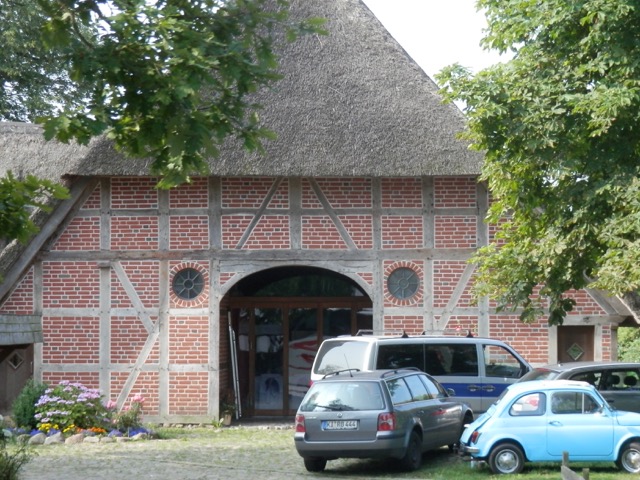
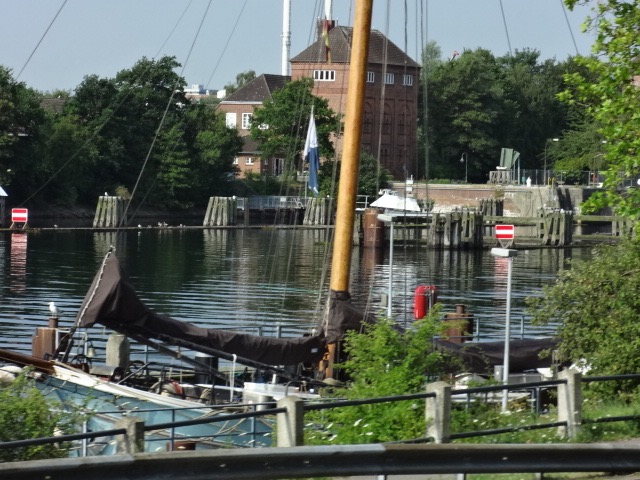

Kiel sits on the edge of Kiel Fjord, a deep-water inlet from the Baltic Sea just south of Denmark. It is also the locus for the east end of the Kiel Canal, originally built by Kaiser Wilhelm II for military purposes but now the most frequented canal in the world. (Said Isabelle, but I suspect the Panama Canal carries more tonnage.) Our tour did not include photo stops, unfortunately, and with us all sitting on the left side of the bus, we didn't have good shots of some of the landmarks we passed. Saw more Olympic rings, as Kiel had been one of the venues for the 1936 games.



After the tour of Kiel, we headed around the fjord to the east side and drove up to the coast to the village of Laboe. A short but steep cobbled street took us from the parking lot down to the water's edge. Walked along to a little bistro called Bernstein where we had our choice of fish roll, the herring sandwich that is the local specialty. We each tried some of both, the salted herring and the pickled herring (with a local beer), and decided we liked the pickled one best.


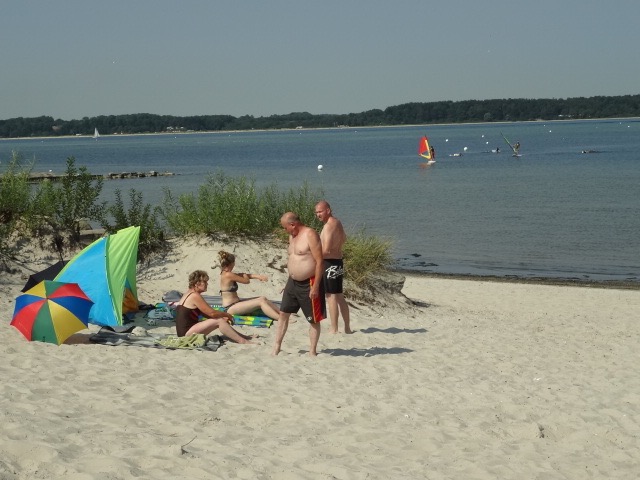

From there we walked down the street a hundred yards or so to the Navy Memorial. Isabelle gave us an overview of the site while we stood outside, then we went in, checking out the display of ship models (including one of the Bismarck, so massive in comparison to the other models that you'd think it was built to a different scale, but it wasn't), then proceeding underground to the crypt, bathed in dim blue light from a stained-glass skylight and surrounded by flags, wreaths and other memorial tributes.


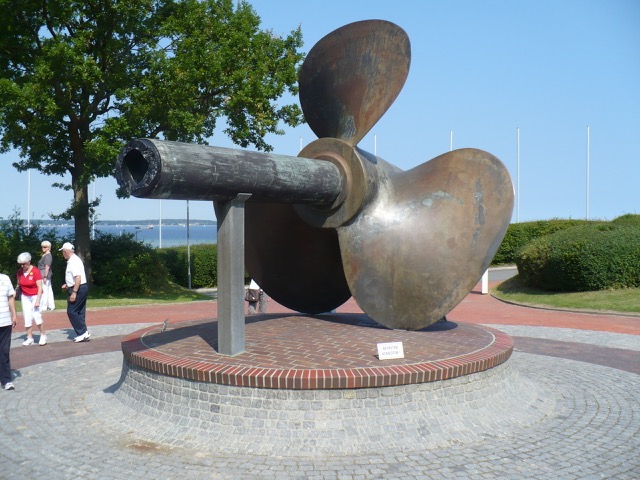







Up through a sloping arched corridor to the ground level and a room displaying graphically the quantity of German ships lost in each of the two world wars. The numbers were staggering. Rode the elevator to the observation level of the imposing red brick tower that is the most visible symbol of the memorial. The shape of the tower is meant to evoke the prow of a Viking longship, or that's what we heard. Took the few flights of stairs to the top level, essentially the roof, which at 85 meters high afforded an awesome panoramic view of the entire area. Took pictures, and could even spot the Eurodam from there.

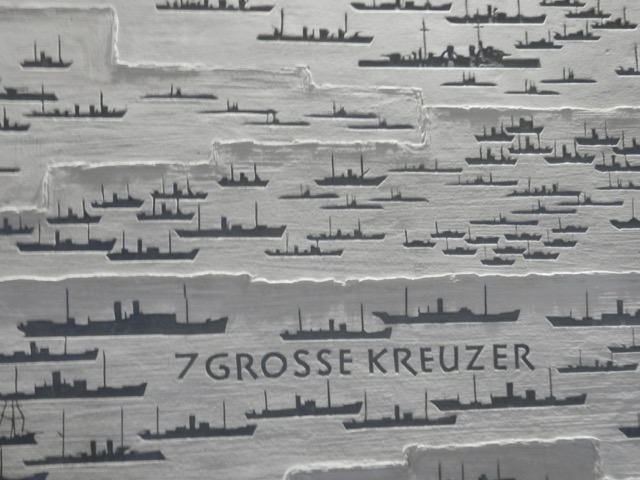




Across the street from the museum entrance sits the only remaining Class VII U-boat in existence, U995. Our tour included admission to the sub, which incidentally was used for the filming of the movie "Das Boot." Entered at the aft torpedo room, and sort of squirmed our way past the battery room, the engine room, sleeping area, control room, radio room, two toilets, and exited from the forward torpedo room. The boat is cramped to the point of being claustrophobic, and the lack of air circulation on the sunny day didn't help any. Can't imagine crews spending weeks, or even days, in such tight quarters. But it was a unique experience.




Trudged back up the steep hill to the bus, and then returned to Kiel and the pier. Instead of boarding our ship, we headed the other direction to check out the shopping. Walked around quite a lot, found a couple stores to visit, and even discovered the pedestrian boulevard. Kiel doesn't seem to have fully embraced the tourist industry, judging from the shortage of souvenir stores, but maybe that's part of its charm. A city of only 250,000, it was much more laid back and not nearly as crowded as Berlin. We stopped at the Starbucks for another collectable mug for Jill and something cold to drink for the rest of us, as the temperature was warm. Mark had to order a cup of hot tea and a large cup of ice in order to get his iced tea fix; the locals apparently didn't understand the concept. Didn't buy anything else, aside from a few items from the maritime shop and a World Cup t-shirt for nephew Jason at a nearby sporting goods store. We strolled back to the ship and then took a nap.


We trudged up to the aft Lido for the sail-away party, and grabbed a German beer while we watched the ship move up the fjord, dozens of white sails dotting the blue waters and hundreds of locals enjoying the beaches on a pleasant summer afternoon. Passed the Kiel canal to our left and the Navy Memorial to our right as we churned into the Baltic.


The Crow's Nest was packed, so we tried the Silk Den. Same view, but amidships. It was empty. Spent a lot of time there, as the view was nice and Bill and Karen found us and we all chatted until time to shower and change for dinner. The daily shipboard guide showed the Atrium Bar open from 5 to 8, so Mark thought he'd try it again. Every time we had checked the bar during our voyage it had not been open. The same was true today. Lauri and Jill hadn't arrived yet, so Mark headed up and aft to look at the most recent pictures in the Photo Gallery. Pulled all the prints he could find and had the staff file them with the others, then backtracked to the Pinnacle Bar, our backup bar choice for the evening. Charlie came by (Charles, our Hotel Manager) and we asked him about the Atrium Bar. He explained that that particular bar just wasn't working out, it being adjacent to the customer service desk, so he gave us permission to cross it off the requirements list. Had another excellent dinner in the Rembrandt, followed by a few laps around the Prom.
By this time we were approaching the big suspension bridge that connects the Danish islands of Funen and Zealand. Mark started watching the approach from our veranda about 10:45, as the last bit of light was waning. The bridge seemed way too low, as if he were looking down on the roadway, and he was only on Deck 7. He wanted to see how close the bridge came to the funnel, so went topside and found a spot along the railing on Deck 10. Of course, the ship cleared the bridge with about 10 meters to spare (or so said the Captain), but to him it looked a lot closer. Jill had taken her camera with her, so caught the transit from the Promenade. Lauri was in the casino, and missed the bridge because she'd gotten the time wrong, thinking the crossing was at 11:45 instead. While there, she closed out her account, as it was the last day of sailing, and the casino is closed while the ship is in port. Eventually, we all headed to bed.
